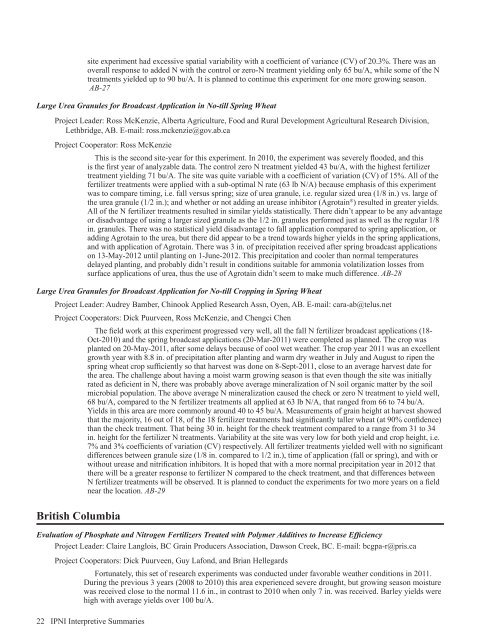Americas and Oceania Group - International Plant Nutrition Institute
Americas and Oceania Group - International Plant Nutrition Institute
Americas and Oceania Group - International Plant Nutrition Institute
Create successful ePaper yourself
Turn your PDF publications into a flip-book with our unique Google optimized e-Paper software.
site experiment had excessive spatial variability with a coefficient of variance (CV) of 20.3%. There was an<br />
overall response to added N with the control or zero-N treatment yielding only 65 bu/A, while some of the N<br />
treatments yielded up to 90 bu/A. It is planned to continue this experiment for one more growing season.<br />
AB-27<br />
Large Urea Granules for Broadcast Application in No-till Spring Wheat<br />
Project Leader: Ross McKenzie, Alberta Agriculture, Food <strong>and</strong> Rural Development Agricultural Research Division,<br />
Lethbridge, AB. E-mail: ross.mckenzie@gov.ab.ca<br />
Project Cooperator: Ross McKenzie<br />
This is the second site-year for this experiment. In 2010, the experiment was severely flooded, <strong>and</strong> this<br />
is the first year of analyzable data. The control zero N treatment yielded 43 bu/A, with the highest fertilizer<br />
treatment yielding 71 bu/A. The site was quite variable with a coefficient of variation (CV) of 15%. All of the<br />
fertilizer treatments were applied with a sub-optimal N rate (63 lb N/A) because emphasis of this experiment<br />
was to compare timing, i.e. fall versus spring; size of urea granule, i.e. regular sized urea (1/8 in.) vs. large of<br />
the urea granule (1/2 in.); <strong>and</strong> whether or not adding an urease inhibitor (Agrotain ® ) resulted in greater yields.<br />
All of the N fertilizer treatments resulted in similar yields statistically. There didn’t appear to be any advantage<br />
or disadvantage of using a larger sized granule as the 1/2 in. granules performed just as well as the regular 1/8<br />
in. granules. There was no statistical yield disadvantage to fall application compared to spring application, or<br />
adding Agrotain to the urea, but there did appear to be a trend towards higher yields in the spring applications,<br />
<strong>and</strong> with application of Agrotain. There was 3 in. of precipitation received after spring broadcast applications<br />
on 13-May-2012 until planting on 1-June-2012. This precipitation <strong>and</strong> cooler than normal temperatures<br />
delayed planting, <strong>and</strong> probably didn’t result in conditions suitable for ammonia volatilization losses from<br />
surface applications of urea, thus the use of Agrotain didn’t seem to make much difference. AB-28<br />
Large Urea Granules for Broadcast Application for No-till Cropping in Spring Wheat<br />
Project Leader: Audrey Bamber, Chinook Applied Research Assn, Oyen, AB. E-mail: cara-ab@telus.net<br />
Project Cooperators: Dick Puurveen, Ross McKenzie, <strong>and</strong> Chengci Chen<br />
British Columbia<br />
The field work at this experiment progressed very well, all the fall N fertilizer broadcast applications (18-<br />
Oct-2010) <strong>and</strong> the spring broadcast applications (20-Mar-2011) were completed as planned. The crop was<br />
planted on 20-May-2011, after some delays because of cool wet weather. The crop year 2011 was an excellent<br />
growth year with 8.8 in. of precipitation after planting <strong>and</strong> warm dry weather in July <strong>and</strong> August to ripen the<br />
spring wheat crop sufficiently so that harvest was done on 8-Sept-2011, close to an average harvest date for<br />
the area. The challenge about having a moist warm growing season is that even though the site was initially<br />
rated as deficient in N, there was probably above average mineralization of N soil organic matter by the soil<br />
microbial population. The above average N mineralization caused the check or zero N treatment to yield well,<br />
68 bu/A, compared to the N fertilizer treatments all applied at 63 lb N/A, that ranged from 66 to 74 bu/A.<br />
Yields in this area are more commonly around 40 to 45 bu/A. Measurements of grain height at harvest showed<br />
that the majority, 16 out of 18, of the 18 fertilizer treatments had significantly taller wheat (at 90% confidence)<br />
than the check treatment. That being 30 in. height for the check treatment compared to a range from 31 to 34<br />
in. height for the fertilizer N treatments. Variability at the site was very low for both yield <strong>and</strong> crop height, i.e.<br />
7% <strong>and</strong> 3% coefficients of variation (CV) respectively. All fertilizer treatments yielded well with no significant<br />
differences between granule size (1/8 in. compared to 1/2 in.), time of application (fall or spring), <strong>and</strong> with or<br />
without urease <strong>and</strong> nitrification inhibitors. It is hoped that with a more normal precipitation year in 2012 that<br />
there will be a greater response to fertilizer N compared to the check treatment, <strong>and</strong> that differences between<br />
N fertilizer treatments will be observed. It is planned to conduct the experiments for two more years on a field<br />
near the location. AB-29<br />
Evaluation of Phosphate <strong>and</strong> Nitrogen Fertilizers Treated with Polymer Additives to Increase Efficiency<br />
Project Leader: Claire Langlois, BC Grain Producers Association, Dawson Creek, BC. E-mail: bcgpa-r@pris.ca<br />
Project Cooperators: Dick Puurveen, Guy Lafond, <strong>and</strong> Brian Hellegards<br />
Fortunately, this set of research experiments was conducted under favorable weather conditions in 2011.<br />
During the previous 3 years (2008 to 2010) this area experienced severe drought, but growing season moisture<br />
was received close to the normal 11.6 in., in contrast to 2010 when only 7 in. was received. Barley yields were<br />
high with average yields over 100 bu/A.<br />
22 IPNI Interpretive Summaries

















